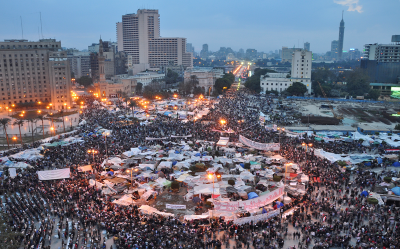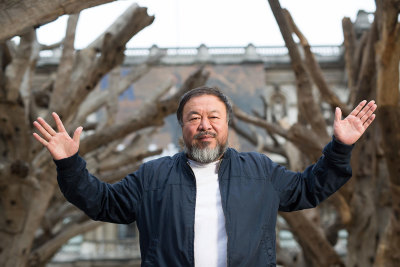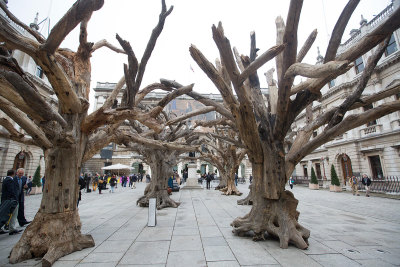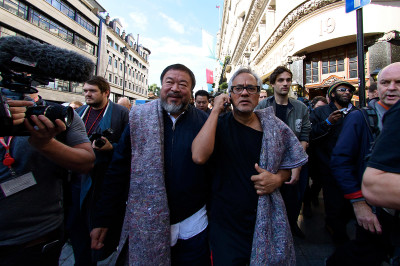Hanging in the corridors of power: when art and politics collide
Hanging in the corridors of power: when art and politics collide
By Tom Jeffreys
Published 21 April 2015
With Britain’s General Election looming, Tom Jeffreys takes a look at the relationship between art and power – in government art collections and on the campaign trail.
-
Barack Obama adjusts his bowtie in the mirror. In the background, part-obscured by a chandelier, is a brightly coloured abstract painting: Berkeley No.52, by American artist Richard Diebenkorn – currently the subject of a major exhibition in the RA’s Sackler galleries.
The photograph, by Pete Souza, was taken in the Yellow Oval Room of the White House, part of the first family’s private living quarters, and demonstrates the exceptional regard in which Diebenkorn’s work is held in his native country. But Souza’s image is also an official White House photograph. It has been sanctioned for publication, if not in person by Obama, then certainly by his administration.
Obama is arguably the most media-savvy US president of all time. In 2008, for example, his election campaign was swift to embrace Shepard Fairey’s red and blue ‘Hope’ poster. It was described by Peter Schjeldahl in the New Yorker as “the most efficacious American political illustration since ‘Uncle Sam Wants You’”. Today, on social media Obama moves effortlessly from matey selfies to statesmanlike poses. He has over 58 million followers on Twitter (by comparison, David Cameron has less than one million). Obama understands the importance of culture, especially visual culture.
-

Artist Shepard Fairey's 'Hope' poster came to symbolise the 2008 Obama presidential campaign
Image by Flickr user Keith Robinson. Used under CC BY-ND 2.0 licence. Some rights reserved
-
Of course, he is by no means the first. Emperors on gold coins; Ingres’ portrait of Napoleon; socialist realism in the Soviet Union: art has long been used to convey political authority. By and large, history’s most striking examples are from authoritarian regimes. In liberal democracies, however, the relationship between art and politics may be less didactic, but it is arguably more complicated. For the today’s politicians, there is almost no such thing as private.
It was in 1961 that Jacqueline Kennedy became the first to recognise the White House as a public museum. Now, under the Obama administration, it has become more open than ever before. One major initiative has been the partnership with Google Art Project to provide 360° views of the rooms on the public tours. As First Lady Michelle Obama has said: “The White House isn’t simply a home to First Families or meeting space for world leaders, it’s also known as ‘The People’s House’, a place that should be open to everyone.”
It’s not just the White House. America’s embassies across the world also contain works of art. So too do Britain’s. America’s government buildings receive loans from national and private collections through the Art in Embassies programme (the Diebenkorn painting in the White House is on loan from the National Gallery of Art). The UK, meanwhile, has a separate collection for such purposes. The Government Art Collection was founded in 1898 to save money (art was cheaper then than wallpaper!), and exists today to promote British art in government buildings in the UK and all around the world. While the US and UK may have different approaches, their aims are broadly similar. Secretary of State John Kerry, for example, has said:
“For 50 years, Art in Embassies has played an active diplomatic role by creating meaningful cultural exchange through the visual arts…. Extending our reach, amplifying our voice, and demonstrating our inclusiveness are strategic imperatives for America.”
-

Ed Vaizey, Minister for Culture, selecting works at the Government Art Collection with Director, Penny Johnson
© Crown Copyright
-
Penny Johnson, Director of the Government Art Collection since 1997, describes it as “cultural diplomacy”. Art, she says, “can provide discussion points, or flatter host nations.” In such environments, art therefore serves a useful social and diplomatic function: “There is an immediacy to the visual arts that transcends language,” she explains.
But it also does more than that. “Art communicates messages,” says Johnson. In a political context, these can be both conscious and unconscious: under Margaret Thatcher, for example, portraits of military and naval officers predominated. Such “traditional” choices tell us not just about personal taste, but about how politicians wish to be perceived – by their peers and, increasingly, the public.
When Tony Blair arrived at Number 10 in 1997, he brought in works by artist of his own generation, such as Anish Kapoor RA. Cherie Blair insisted on more female faces: hence a portrait of Ada Lovelace. “Labour were very interested in contemporary art,” explains Johnson. “It was one way of giving greater recognition to a modern Britain.” The Cameron administration has continued this emphasis on the contemporary. With a UK general election taking place in May, it remains to be seen which politicians will have artistic choices to make, and what these choices will say about them.
In 2002, Paul (now Lord) Boateng chose a text painting, entitled Peas Are the New Beans, by Bob and Roberta Smith RA to hang in the waiting room at the Treasury. He also chose the work for the Government Art Collection exhibition at the Whitechapel Gallery in 2011: clearly, Boateng was willing to ally himself to this work both in the professional context of the Treasury office and to the wider public.
It was certainly an interesting choice: Smith is one of the most directly political artists working in the UK today. His latest project, for example, is the Arts Emergency Response Centre, an immersive exhibition that he curated at the CASS Bank Gallery. Smith is also standing in this year’s general election against Conservative MP Michael Gove. You can read more about Smith’s views on art and politics in the Spring 2015 issue of RA Magazine.
-

Bob and Roberta Smith RA poses with Michael Gove on the campaign trail

Bob and Roberta Smith RA, Peas Are the New Beans, 1999.
-
But does Smith’s work lose its radical claims when employed by a politician? Smith disagrees: “Can art be co-opted? I don’t think it can,” he says. “Art works in Parliament are thorns in the side of politicians who generally do not for a moment understand them. Thank God they are there!”
While Smith may insist on art’s untouchable purity, the history of politics suggests otherwise. In the 1990s, for example, it emerged that the CIA had been using Abstract Expressionism as a “weapon” in the Cold War. Has much changed today? Looking to position himself and Joe Biden as “champions for arts and culture” Obama has argued that such work “helped win the war of ideas by demonstrating to the world the promise of America”. Obama sees parallels in today’s war on terror: “Artists,” he continues, “can be utilised again to help us win the war of ideas against Islamic extremism”.
It is interesting to note the Government Art Collection website describes Smith’s work as “one of a series of authoritative, yet ultimately meaningless statements”. Could it be that the very ambiguity of art is what allows it to be co-opted for other purposes? Could it also be this ambiguity that prevents the totality of such co-option? The emotional response to a work of Abstract Expressionism, for example, is still real and significant, whatever its alleged political past.
Similarly, just as the presence of Berkeley No.52 helps Obama present himself in the right kind of light, so the dissemination of this photo helps to boost Diebenkorn’s reputation abroad. Acquisition and exhibition by eminent institutions contribute to the value of an art work: over time, a work may pass from owner to owner, it may be exhibited in different contexts, be used in different ways, interpreted differently. This history builds a kind of patina upon the work of art which informs our understanding of it.
It is perhaps telling that in Souza’s White House photograph all eyes are on the President’s right hand – his wife’s, his companion’s (a civil servant? the photographer?), his own, and ours too. The foreground is out of focus, so too the Diebenkorn. Nonetheless, the lines of the painting remain strong, the colours vivid. While the political actors perform their roles, the painting retains our interest because it remains ambiguous. Even with Obama around, art is always the most interesting thing in the room.
Richard Diebenkorn is in The Sackler Wing at the RA until 7 June 2015.
Tom Jeffreys (@tomjeffreys) is a writer, editor and curator.







